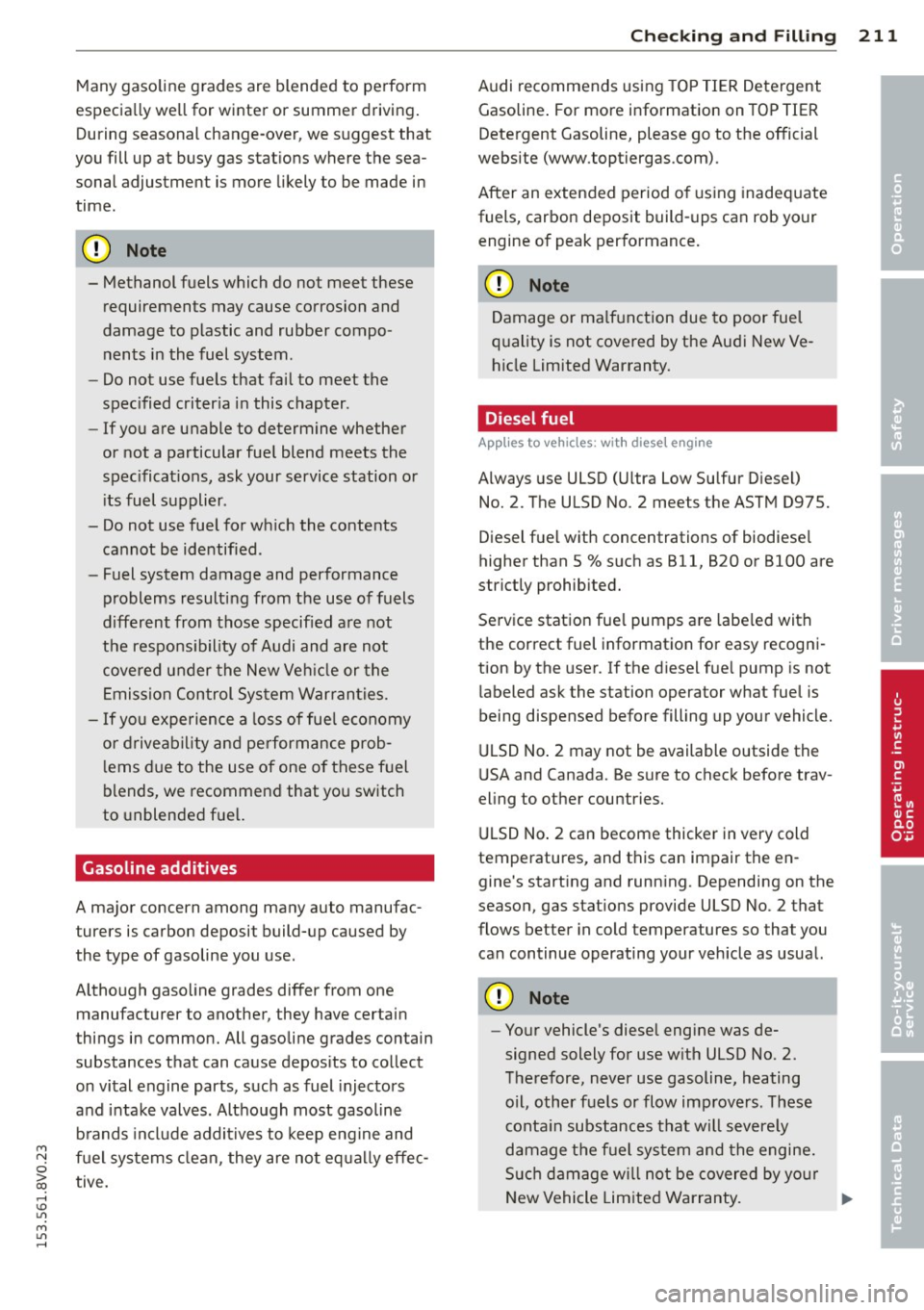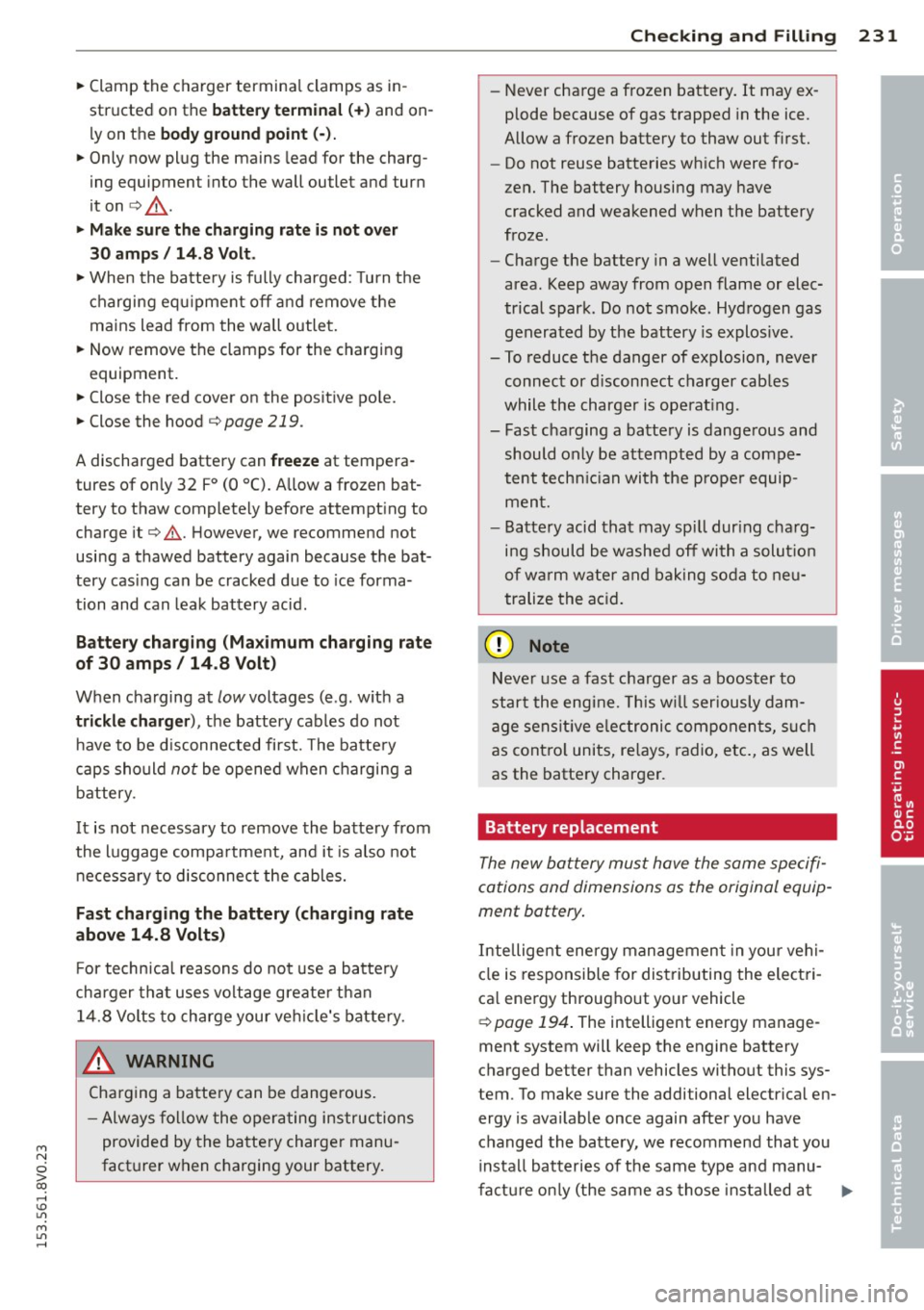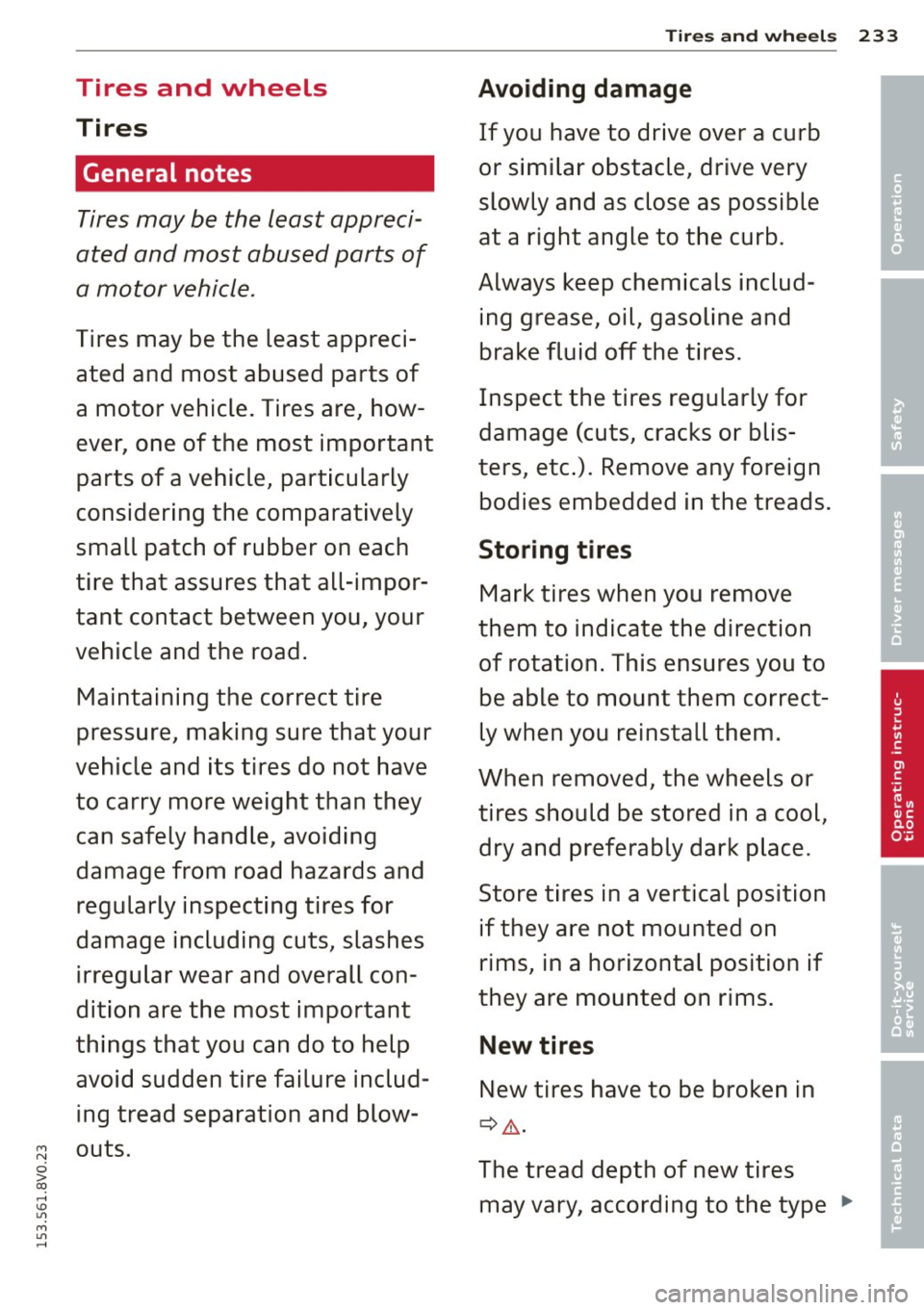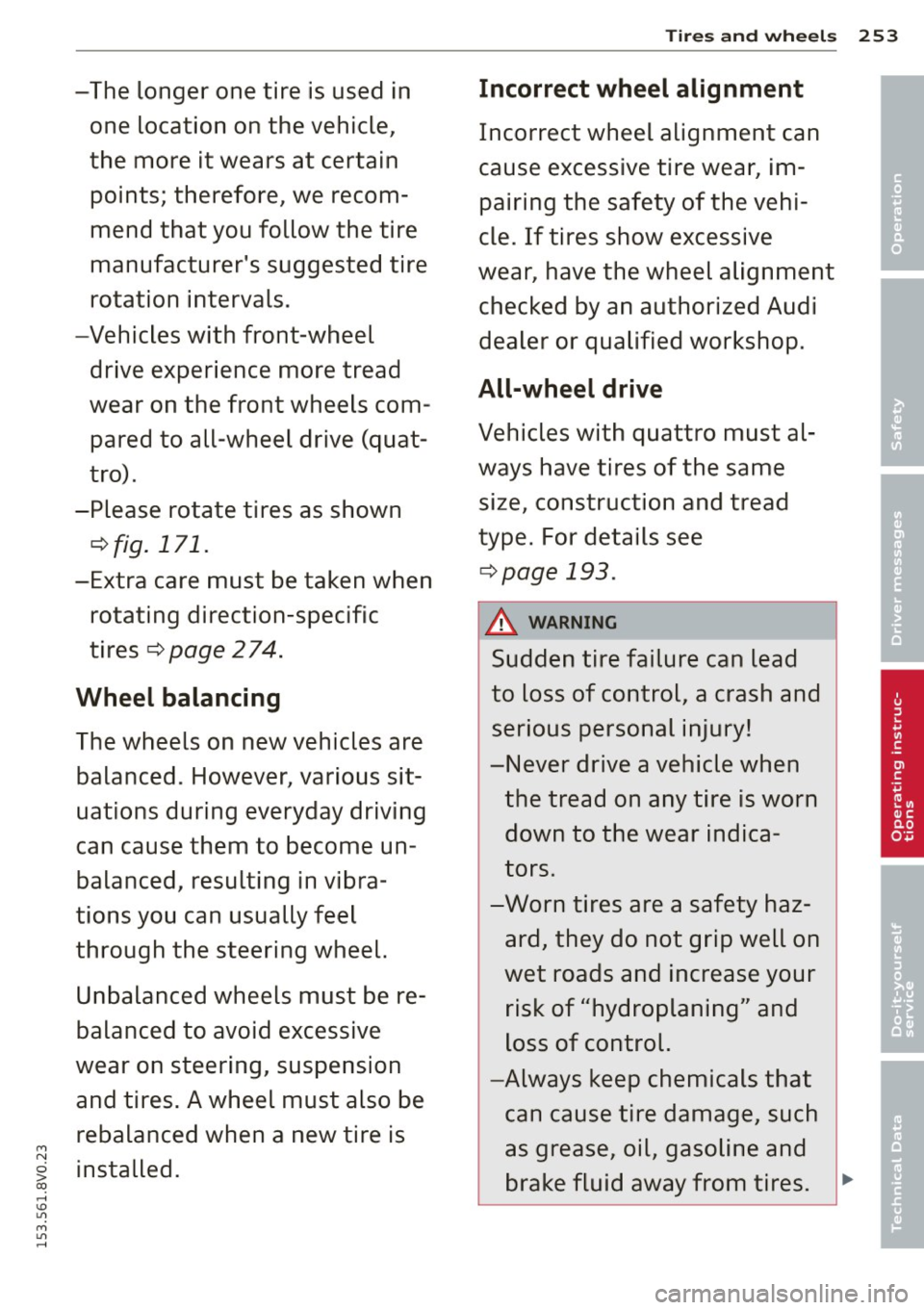gas type AUDI S3 2015 Owners Manual
[x] Cancel search | Manufacturer: AUDI, Model Year: 2015, Model line: S3, Model: AUDI S3 2015Pages: 310, PDF Size: 76.15 MB
Page 54 of 310

52 Lights an d Vi sion
Removing the wip er blad e
.,. Fold the w indshield wiper arm away from
the windshie ld .
.,. Press the locking knob
(D ¬Ę fig. 41 on the
wip er blade . Hold th e wiper blade f irm ly.
.,. Remove the wipe r blade in the direction of
t he arrow.
In stall ing t he wip er blade
.,. Inse rt the new wipe r blade into the mount
on the w iper arm @ until you hear it latch
into place .
.,. Place the wiper arm back on the windshie ld.
.,. Tu rn the serv ice position off.
_& WARNING
For safety reasons, the windshield wiper
blades should be replaced once or twice
each year.
Q) Note
- The w indshield wiper blades must only
be folded away when in the serv ice posi ­
tion . Otherw ise, you risk damag ing the
paint on the hood or the windshield wip­
er motor.
- You should not drive your veh icle or
press the w indshield w iper lever when
the wiper arms are folded away from the
winds hield. The w indshie ld w ipers would
move back into their original position
and could damage the hood and wind­
shield.
- To prevent damage to the windshield
washer system, always loosen wiper
blades that have frozen to the wind­
s h ield before turning the wipers on.
- To prevent damage to the wiper blades,
do not apply gasoline, petroleum, thin­
ning agents or other solvents on the wip­
er blades or near them.
- To prevent damage to the wipe r arms or
other components, do not try to move
the windshie ld w ipers by hand .
-
(D Tips
-Commercial hot wax such as the types
used by car washes make it more d ifficult
to clean the windshie ld.
- You can also use the service position, for
example, if you want to protect the
w indshield from icing by using a cover.
- Yo u cannot activate the serv ice position
when the hood is open .
Outside mirror
Adjusting the exterior mirrors
F ig. 42 Drive r's doo r: kno b fo r th e exte rior mir rors (ex ­
amp le)
T urn the knob to the des ired posit ion:
q;p -In this pos ition, yo u can adjust the
dr iver's and front passenger's exterior m irrors
by turning the knob in the desired direction .
Cffil -The mirrors are heated* depend ing on the
outside temperature and dr iv ing speed .
8 - The ex ter ior m irrors are folded in*.
Front passenge r's ex terior mirror tilt
function*
To he lp you see the curb when backing into a
parking space , the surfa ce of the mirror can
be tilted s light ly. The knob mus t be in the
P pos ition for this to happen .
You can adjust the tilted mir ror surface by
turning the knob in the desired direction.
When you move ou t of reverse and into ano th­
er gear, the new m irror position is stored and
ass igned to the key you are using. .,.
Page 213 of 310

Many gasoline grades are blended to perform
especially well for winter or summer driving. During seasonal change-over, we suggest that
you fill up at busy gas stations where the sea­ sonal adjustment is more likely to be made in
time.
Q;) Note
- Methanol fuels which do not meet these requirements may cause corrosion and
damage to plastic and rubber compo­ nents in the fuel system .
- Do not use fuels that fail to meet the
specified criteria in this chapter .
- If you are unable to determine whether
or not a particular fuel blend meets the
specificat ions, ask your service station or
i ts fuel supp lier.
- Do not use fuel for which the contents cannot be identified.
- Fuel system damage and performance
problems resulting from the use of fuels
different from those specified are not
the responsibility of Audi and are not
covered under the New Vehicle or the
Emission Control System Warranties.
- If you experience a loss of fuel economy
or driveability and performance prob­
lems due to the use of one of these fuel
blends, we recommend that you switch
to unblended fuel.
Gasoline additives
A major concern among many auto manufac­
turers is carbon deposit build-up caused by
the type of gasoline you use .
Although gasoline grades differ from one manufacturer to another, they have certain
things in common. All gasoline grades contain substances that can cause deposits to collect
on vital engine parts, such as fuel injectors
and intake valves. Although most gasoline
brands include additives to keep engine and
M
N fuel systems clean, they are not equally effec-o
iii tive. ,...., \!) ..,.,
M ..,., ,....,
Checking and Filling 211
Audi recommends using TOP TIER Detergent
Gasoline . For more information on TOP TIER
Detergent Gasoline, please go to the official
website (www.toptiergas .com).
After an extended period of using inadequate
fuels, carbon deposit build-ups can rob your engine of peak performance.
CJ) Note
Damage or malfunction due to poor fuel
quality is not covered by the Audi New Ve­
hicle Limited Warranty.
Diesel fuel
App lies to vehicles : wit h diese l eng ine
Always use ULSD (Ultra Low Sulfur Diesel)
No. 2 . The ULSD No. 2 meets the ASTM D975.
Diesel fuel with concentrations of biodiesel
higher than 5
% such as B11, B2O or B1OO are
strictly prohibited.
Service station fuel pumps are labeled with
the correct fuel information for easy recogni­
tion by the user.
If the diesel fuel pump is not
labeled ask the station operator what fuel is
being dispensed before filling up your vehicle.
ULSD No. 2 may not be available outside the
USA and Canada. Be sure to check before trav­
eling to other countries.
ULSD No. 2 can become thicker in very cold
temperatures, and this can impair the en­
gine's starting and running. Depending on the
season, gas stations provide ULSD No . 2 that
flows better in cold temperatures so that you
can continue operating your vehicle as usual.
(D Note
- Your vehicle's diesel engine was de­
signed solely for use with ULSD No. 2.
Therefore, never use gasoline, heating
oil, other fuels or flow improvers. These
contain substances that will severely
damage the fuel system and the engine.
Such damage will not be covered by your
New Vehicle Limited Warranty.
ll>
‚ÄĘ
‚ÄĘ
‚ÄĘ
Page 233 of 310

M N
0 > co ,...., \!) ..,.,
M ..,., ,....,
~ Clamp the charger terminal clamps as in ­
structed on the
b atter y ter min al (+ ) and on­
ly on the
body ground point (·).
~ Only now plug the mains lead for the charg­
ing equipment into the wall outlet and turn
it on
c:> ,.&. .
~ Mak e sure the charging rate i s not o ver
30 amp s / 14.8 Volt .
~ When the batte ry is fully charged: Turn the
c harging equ ipment off a nd remove the
mains lead from the wall outle t.
~ Now remove the clamps for the charging
equipment.
~ Close the red cover on the positive po le.
~ Close the hood <=> page 219.
A discharged battery can freeze at tempera­
tures of on ly 32 F
0 (0 ¬įC). A llow a frozen bat¬≠
tery to thaw completely before attempt ing to
charge it
c:> &. . However, we recommend not
using a thawed battery again because the bat­
tery cas ing can be cracked due to ice forma­
tion and can leak battery acid.
B atter y ch arging (Ma ximum charging rate
of
30 amps / 14.8 Volt)
When cha rging at low voltages (e .g. w ith a
tric kle charger ), the battery cables do not
have to be d isconnected first. The batte ry
caps sho uld
not be opened when charging a
battery .
It is not necessary to remove the batte ry from
the luggage compa rtment, and it is also not
necessa ry to disconnec t the cables.
Fa st charging the b attery (charging rate
above
14.8 Volts )
For technica l reasons do not use a battery
charger that uses voltage g reate r than
14.8 Volts to charge your veh icle's battery.
WARNING
Charging a battery can be dangerous.
- Always fo llow the oper ating instructions
provided by the battery charge r manu­
fact urer when charging your battery.
Checking and Fillin g 231
-Never charge a frozen battery. It may ex­
plode because of gas trapped in the ice .
Allow a frozen battery to thaw out first.
- Do not reuse batteries wh ich were fro­
zen. The battery housing may have
cracked and weakened when the battery
froze.
- Charge the battery in a well ventilated
area. Keep away from open flame or elec­
trical spark. Do not smoke. Hydrogen gas
generated by the battery is explos ive.
- To reduce the danger of explosion, never connect or d isconnect charger cab les
while the charger is ope rat ing.
- Fast charging a batte ry is dangerous and
should only be attempted by a compe­
tent techn ic ian with the prope r equip­
ment.
- Battery acid that may spi ll dur ing cha rg­
ing should be washed off wi th a solut io n
of wa rm w ater and baking soda to neu­
trali ze the ac id.
(D Note
Neve r use a fast cha rger as a boost er to
star t the engine. This w ill ser iously dam­
age sens it ive e lectronic componen ts, su ch
as cont ro l units, re lays, radio, etc., as well
as the battery charger.
Battery replacement
The new battery must have the same specifi­
cations and dimensions as the original equip ­
ment battery.
Inte lligent energy management in your vehi­
cl e is responsible for dist ributing the elect ri­
ca l energy throughout yo ur vehicle
<=> page 194 . The intelligent energy manage­
ment system will keep the engine battery
charged better than vehicles without this sys­
tem . To make sure the additional electrical en­
ergy is ava ilab le once again after you have
changed the batte ry, we recommend that you
insta ll batteries of the same type and manu-
factu re on ly (the same as those installed at
IJI,,
‚ÄĘ
‚ÄĘ
‚ÄĘ
Page 235 of 310

Tires and wheels
Tires
General notes
Tires may be the least appreci­
ated and most abused parts of
a motor vehicle .
Tires may be the least appreci­
ated and most abused parts of
a motor vehicle. Tires are, how­
ever, one of the most important
parts of a vehicle, particularly
considering the comparatively
small patch of rubber on each
tire that assures that all-impor­
tant contact between you, your
vehicle and the road.
Maintaining the correct tire
pressure, making sure that your
vehicle and its tires do not have
to carry more weight than they can safely handle, avoiding
damage from road hazards and
regularly inspecting tires for
damage including cuts, slashes
irregular wear and overall con­
dition are the most important
things that you can do to help avoid sudden tire failure includ­
ing tread separation and blow-
~ outs.
0 > co ,...., \!) 1.1'1
M 1.1'1 ,....,
Tires and wheels 233
Avoiding damage
If you have to drive over a curb
or similar obstacle, drive very
slowly and as close as possible
at a right angle to the curb.
Always keep chemicals includ­ ing grease, oil, gasoline and
brake fluid off the tires.
Inspect the tires regularly for
damage (cuts, cracks or blis­
ters, etc.). Remove any foreign
bodies embedded in the treads.
Storing tires
Mark tires when you remove
them to indicate the direction
of rotation. This ensures you to be able to mount them correct­
ly when you reinstall them.
When removed, the wheels or
tires should be stored in a cool, dry and preferably dark place.
Store tires in a vertical position if they are not mounted on
rims, in a horizontal position if
they are mounted on rims.
New tires
New tires have to be broken in
¬Ę _&. .
The tread depth of new tires
may vary , according to the type .,.
' ‚ÄĘ
‚ÄĘ
' ‚ÄĘ
Page 255 of 310

-The longer one tire is used in one location on the vehicle,
the more it wears at certain points; therefore, we recom­
mend that you follow the tire
manufacturer's suggested tire
rotation intervals.
-Vehicles with front-wheel drive experience more tread
wear on the front wheels com­ pared to all-wheel drive (quat­
tro).
-Please rotate tires as shown
¬Ę fig. 171.
-Extra care must be taken when
rotating direction-specific
tires
Q page 2 74.
Wheel balancing
The wheels on new vehicles are balanced. However, various sit­
uations during everyday driving
can cause them to become un­
balanced, resulting in vibra­
tions you can usually feel
through the steering wheel.
Unbalanced wheels must be re­
balanced to avoid excessive
wear on steering, suspension
and tires. A wheel must also be
rebalanced when a new tire is
M N
~ installed. co ,...., \!) 1.1"1
M 1.1"1 ,....,
Tires and wheels 253
Incorrect wheel alignment
Incorrect wheel alignment can
cause excessive tire wear, im­pairing the safety of the vehi­
cle. If tires show excessive
wear, have the wheel alignment checked by an authorized Audi
dealer or qualified workshop.
All-wheel drive
Vehicles with quattro must al­
ways have tires of the same size, construction and tread
type. For details see
¬Ę page 193 .
.8, WARNING
Sudden tire failure can lead
to loss of control, a crash and serious personal injury!
-Never drive a vehicle when the tread on any tire is worn down to the wear indica­
tors.
-Worn tires are a safety haz­ ard, they do not grip well on
wet roads and increase your risk of "hydroplaning" and
loss of control.
-Always keep chemicals that can cause tire damage, such
-
as grease, oil, gasoline and
brake fluid away from tires.
~
' ‚ÄĘ
‚ÄĘ
' ‚ÄĘ